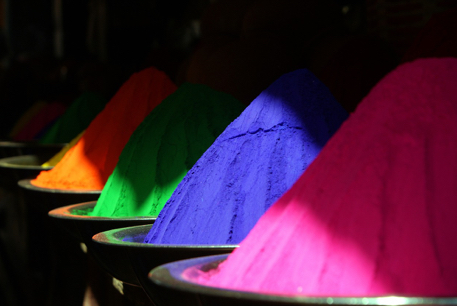

From lively smears of color, to melodious music, Holi, the Hindu festival of vibrant colors and joyful spirits, represents the triumph of good over evil, through various social gatherings and traditions. This year, Holi is celebrated on Monday, March 25 but it varies each year depending on the lunar cycle. The date is determined by the Hindu calendar, marking the end of winter on the last full moon day of the Hindu luni-solar calendar month, and signaling the start of spring.
The celebration of Holi holds much cultural and religious significance in Hinduism. Traditionally, it is an all day festival to rid oneself of past errors, end conflicts, and a day to forgive and forget.’ There is a profound connection between the festivity and spirituality in the significance of Holi.
Sophomore Sarna Paul said, “We focus more on celebrating the gods, rather than throwing powder at each other. To me, Holi means celebrating the love between Radha and Krishna, and the victory of good over evil. There’s a whole story and Hindu mythology behind the reason we celebrate Holi.”
In Hinduism, there are many gods and goddesses that have their own characteristics and myths associated with them. The most well-known legend relating to Holi is the story of Holika and Prahlad. Prahlad was a devotee of Lord Vishnu rather than his father, who wanted to be regarded as a god. When Prahlad kept refusing his requests, his father tried to kill him, but he was always saved by Lord Vishnu.
In the end, Prahlad’s sister, Holika, attempted to trick Prahlad into sitting on her lap on a pyre, which would help fulfill their father’s wishes. However, with Prahlad’s devotion to Lord Vishnu, Prahlad was unharmed while his sister was taken by the flames, even when she was immune to them. The story illustrates how important it is for righteousness to be valued over oppression and tyranny.
Junior Sithi Das said, “This legend is important to our Hindu culture as it explores the victory of good over evil. This message can even be applied to our everyday lives, especially when we might be discouraged by the negative things that may be happening in our lives. Holi is an important celebration that encourages people to [understand] these lessons and embody them in their personal lives.”
When asked about what Holi meant to them, freshman Priyanka Sarkar said, “To me, Holi is a day where I can enjoy my cultural and religious traditions and spend a day with my family, focusing on the good rather than the bad. It encourages me to spread positivity and love with others close to me.”
Similarly, junior Puja Biswas said “For me, Holi gives me the chance to spend time with my friends and family as well as pray at my local temple. It’s important to be spiritually connected to the gods and goddesses that have [shown] us the power of good rather than evil, especially during Holi.”
Food also plays an important role in these festivals, as Holi marks the transition to Spring and it is thought of as the time to celebrate nature’s bounty and abundance of food. One of the largest parts of Holi celebrations includes the exchanging of sweets, snacks, and thandai (an Indian cold drink) with others in the South Asian community. Some of the most popular Holi foods include Gujiya, Lassi, and Rasmalai.
Sarna said, “On Holi, I usually eat vegetarian foods that we cook during Hindu holidays and pujas, so we get to indulge in familiar dishes, but with more variety.”
Throughout the world, however, these customs and traditions of Holi may vary from person to person. Sophomore Michelle Moses emphasized this and said, “Since my parents are both from Guyana, we refer to Holi as Phagwah, but the celebration mainly remains consistent. For Phagwah, we eat certain sweets such as Parasad, Peera, Barfi, and Mithai that are usually made during this time of celebration.”
Additionally, Holi is not only a festival of colors but also a celebration of vibrant attire. There are many elegant clothing choices during this festival, including saris, lehengas, and kurtis for women, and kurtas and dhotis for men. With the tradition of throwing powdered colors onto each other, many opt to wear white garments that can later evolve into a festive rainbow at the end of the day.
Freshman Maliha Duggal said, “Getting dressed up during Holi is one of my favorite parts of the holiday, I’ll usually wear a white sari.” Saris are a piece of clothing commonly worn on festive occasions in which a woven fabric is arranged over the body as a robe with one side attached to the hip.
Priyanka said, “I wear a salwar kameez during the festival, especially since it’s comfortable and I’m able to move around in it more, which helps me get through the long day of celebration.” Salwar kameezes are known to be a form of traditional clothing from regions in South Asia, which consists of pants, a long tunic, and a scarf.
On March 25, the Freshman Grade Leaders will be hosting a Holi event in the THHS courtyard, which will give students from across the school to see what a Holi celebration is like.
Sophomore Brandon Pinto said he is looking forward to the school celebration: “Although I am Indian, the festival is not celebrated in my household. I’ve heard it can be quite fun, and I’m excited to finally be able to take part in the tradition with the Holi event at THHS.”




























